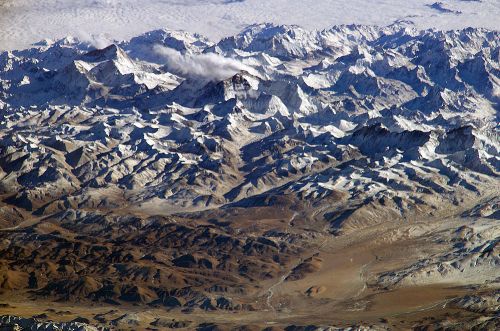by Larry
May, 2010Trouble at the Third PoleThe region is the Tibetan Plateau, a fundamental hub for not merely south Asia but for our political and economic security generally. Despite documentaries about European or American climbers on some of its more heralded peaks, such as Everest, this portion of the planet's surface is not well known in the West. Few are aware, for instance, that (per Wikipedia) there is on the Tibetan Plateau a gorge, the Tsangpo Canyon, even longer and deeper than that vast wonder of American tourism, the Grand Canyon. So important an arctic-like place it is sometimes called the world's Third Pole, what is most critical about the region these days, however, is that its store of frozen water, the annual runoff from which supplies such essential rivers as the Brahmaputra, Ganges, Mekong, Salween, Yangtze, Yarlung, Tsangpo, Yellow, and more, is disappearing. In places, 35% of the glaciers and other ice of the region have so far melted. By 2025, some experts say, so much more will have been lost that this Third Pole will no longer be able to serve the needs of the huge population and agricultural centers that surround it and require it for life itself. It would take hundreds of years of colder climate to restore the Third Pole's formerly secure deep freeze status. Arguments about who is or is not to blame may be beside the point here. If trends continue, in less than a generation there may be tragedy on an unprecedented scale. As the pace of snow and glacier melting on the Tibetan Plateau has increased, once fresh, potable mountain stream water is awash with flooding torrents that contain too much sediment for easy use by villagers. Alternatively, they must trek farther for water now available only at a considerable distance as glaciers previously on their doorstep are in retreat. Sometimes waterways which once steadily fed the area's major river systems have become erratic, in flood at times, considerably reduced at others. These are but early symptoms of difficulties much more substantial ahead for this region larger in area than Western Europe and with an average altitude of greater than two miles.
Costly geographic and climate related alterations are all too quickly becoming an implacable fact of life in south and east Asia. Vast numbers are potentially at risk. Space on the surface of our globe is not so open that such masses may be easily relocated. Yet this part of the world is even now considered unstable. Some measures may be possible that would lessen the eventual impact of the transformation now underway on the Plateau of Tibet. If and when catastrophe occurs, how will the rest of the world respond? Will those who currently are better off seal their borders and hunker down while turmoil and devastation rule in the sphere's most populous and vulnerable places? Or can we begin soon to take action to mitigate a looming disaster? During the early part of the 20th Century, many warned of the consequences of Hitler's rise and consolidation of power, yet, then as now, dithering, finger-pointing, and denial were the order of the day. Over 20 million people lost their lives in World War II. The harm from looming Tibetan Plateau changes could dwarf those numbers, maybe by 100 to 1. If astronomers could tell that an asteroid were hurtling toward Earth and by sophisticated means were able to determine the collision point, that the big rock would intercept our planet in 2025, and that upwards of two billion of us might be killed from the immediate disaster plus its aftereffects, I wonder if we could find a way to cooperate in the years remaining and pool our efforts to save as many as possible, or if, faced with a majority of scientists making that call, we would prefer till too late to question their conclusions and then, when they could not longer be doubted, say it was too bad, but nothing could be done. Hopefully in this case the circumstances are not so dire, but they might be, and we have too few years left in which to prepare. Once millions are dying of thirst or starvation, it will be a bit late to take effective action. In Texas, as well as in many other places, road projects and other infrastructure needs and concerns are planned decades in advance. They have to be, because it is clear they are too complicated, affected by too many intertwined variables, and dependent on too many years of preliminary endeavors for adequate preparation, preliminary constructions, funding measures, and so forth to be handled just on a short-term or crisis to crisis basis. We may argue whether or not the current transportation system is sufficient for the requirements of a growing population, but clearly we are all much better off because such things are dealt with by considering the relevant factors over the long haul and then making the necessary arangements. What seems to be sorely lacking, however, is some equivalent international and coordinated planning strategy for dealing with critical, complicated matters that most everyone can see are coming down the pike, whether they be "unanticipated" accidents with deep ocean drilling, failures of super large corporations whose executives indulge in vast amounts of risk taking, knowing they will eventually be bailed out by taxpayers and shareholders, regional alterations in climate that will have sweeping implications for the people who unfortunately had depended on the status quo being maintained, etc. By contrast, we appear in some ways on the global scene to as yet be operating like folks might have in a pre-industrial village. None should be surprised if the consequences of such short-sightedness wind up being rather negative. Primary Source: The Big Melt. Brook Larmer in National Geographic, Volume 217, Number 4, pages 60-79; April, 2010. |
